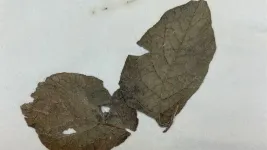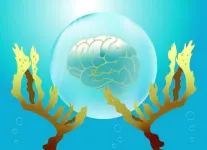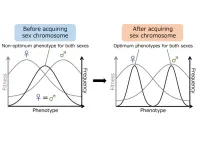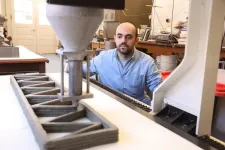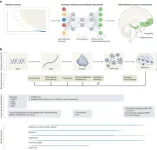(Press-News.org) In an examination of the genetic material found in historic potato leaves, North Carolina State University researchers reveal more about the tit-for-tat evolutionary changes occurring in both potato plants and the pathogen that caused the 1840s Irish potato famine.
The study used a targeted enrichment sequencing approach to simultaneously examine both the plant’s resistance genes and the pathogen’s effector genes – genes that help it infect hosts – in a first-of-its-kind analysis.
“We use small pieces of historic leaves with the pathogen and other bacteria on them; the DNA is fragmented more than a normal tissue sample,” said Allison Coomber, an NC State former graduate student researcher and lead author of the paper. “We use small 80 base-pair chunks like a magnet to fish out similar pieces in this soup of DNA. These magnets are used to find resistance genes from the host and effector genes from the pathogen.”
“This is a first for looking at both potato and pathogen changes at the same time; usually researchers look at one or the other,” says Jean Ristaino, William Neal Reynolds Distinguished Professor of Plant Pathology at North Carolina State University and corresponding author of a paper in Nature Communications that describes the study. “The dual enrichment strategy employed here allowed us to capture targeted regions of genomes of both sides of the host-pathogen relationship, even when host and pathogen were present in unequal amounts. We couldn’t have done this work 15 years ago because the genomes weren’t sequenced.”
The study’s results show that the pathogen, Phytophthora infestans, is very adept at fighting off potato late blight disease resistance. For example, the study shows that the FAM-1 strain of the pathogen had the ability to defeat the resistance provided by the plant’s R1 resistance gene – even before plant breeders deployed it in potato.
“The pathogen would have been able to resist this R1 resistance gene even if it had been deployed years earlier, probably because it was exposed to a potato with that resistance gene in the wild,” Coomber said.
The study also shows that many of the pathogen’s effector genes have remained stable, although different mutations have occurred to increase its infection prowess as plant breeders attempted to breed resistance – specifically after 1937 when more structured potato breeding programs commenced in the United States and other parts of the globe.
The study also shows that the pathogen added a set of chromosomes between 1845 and 1954, the period of time in which the study’s plant samples were collected.
“We show in this work that after 100 years of human intervention, there are some genes that haven’t changed much in the pathogen,” Coomber said. “They are very stable potentially because they haven’t been selected on, or because they are really important to the pathogen. Targeting those genes would make it really hard for the pathogen to evolve an opposing response.”
“It’s hard to do effective plant breeding when we don’t know enough about the pathogen. Now that we know what effectors have changed over time, breeders may be able use resistance genes that are more stable or pyramid multiple resistance genes from different wild hosts,” Ristaino said.
“That’s where I see the future for this type of study – applying it to slow changes in pathogen virulence or other traits such as fungicide resistance.”
Amanda C. Saville, a research and laboratory specialist in Ristaino’s lab, also co-authored the paper. Funding was provided by a seed grant from the Triangle Center for Evolutionary Medicine, by National Science Foundation AgBioFews Training Grant Number 2018-1966 and by Grip4PSI Grant Number 557299.
- kulikowski -
Note to editors: The abstract of the paper follows.
“Evolution of Phytophthora infestans on its Potato Host since the Irish Potato Famine”
Authors: Allison Coomber, Amanda Saville and Jean B Ristaino, NC State University
Published: Aug. 5, 2024 in Nature Communications
DOI: 10.1038/s41467-024-50749-4
Abstract: Since the Irish Potato Famine of 1845-1852, late blight caused by the plant pathogen Phytophthora infestans has continued to plague potato (Solanum tuberosum) fields worldwide. In the years after the famine, plant breeders deployed potato varieties with resistance (R) genes to the pathogen. These R genes allow the host plant to recognize pathogen effector genes which are responsible for virulence, and after recognition, shut down disease progression. The host and pathogen began an arms race that resulted in the pathogen overcoming many R genes that were deployed. How these gene families evolved over time in tandem is not well understood. Herein, we show that that currently relevant pathogen effector genes have historically been present in P. infestans but with alternative alleles compared to the modern reference genome. We found that the historic FAM-1 lineage had the virulent allele for Avr1 and the ability to break the R1 resistance gene, before plant breeders had deployed it in potato. The pathogen also underwent an increase in chromosome number, from diploid to triploid after the famine. Our results show that both pathogen virulence genes and host resistance genes have undergone significant changes since the Famine, likely both from natural and artificial selection.
END
Caltech researchers have developed a new method to measure soil moisture in the shallow subterranean region between the surface and underground aquifers. This region, called the vadose zone, is crucial for plants and crops to obtain water through their roots. However, measuring how this underground moisture fluctuates over time and between geographical regions has traditionally relied on satellite imaging, which only gives low-resolution averages and cannot penetrate below the surface. Additionally, moisture within the vadose zone changes rapidly—a thunderstorm can saturate a region that dries ...
AURORA, Colo. (August 5, 2024) – In a first-of-its-kind study, a cohort of researchers, led by the University of Colorado Anschutz Medical Campus, evaluated the effects of state-level insulin out-of-pocket costs across states and payers and over time. The team found that state-level caps on insulin out-of-pocket costs do not significantly increase insulin claims for patients with Type 1 or patients using insulin to manage Type 2 diabetes. Study results could help inform policies aimed at better delivering cost-capped insulin to patients struggling with insulin affordability.
Approximately ...
Parkinson’s disease is a neurodegenerative disease caused by the loss of neurons that produce dopamine, a neurotransmitter involved in motor control and cognitive function. As the global population ages, the number of Parkinson's disease patients is rapidly increasing. Parkinson's disease is induced by neuronal damage due to excessive production of reactive oxygen species.
Suppression of reactive oxygen species generation is essential because it is fatal to dopaminergic neurons that manage dopamine neurotransmitters. ...
Light pollution disrupts circadian rhythms and ecosystems worldwide – but for plants, dependent on light for photosynthesis, its effects could be profound. Now scientists writing in Frontiers in Plant Science have found that exposure to high levels of artificial light at night makes tree leaves grow tougher and harder for insects to eat, threatening urban food chains.
“We noticed that, compared to natural ecosystems, tree leaves in most urban ecosystems generally show little sign of insect damage. We were curious as to why,” said corresponding author Dr Shuang Zhang of the Chinese Academy of Sciences. “Here we show that in ...
Mental health screenings must be incorporated in routine prostate cancer diagnoses say University of South Australia researchers. The call follows new research that shows men need more supports both during and immediately after a diagnosis of prostate cancer.
Funded by Movember, the UniSA study tracked the scale and timing of mental health issues among 13,693 South Australian men with prostate cancer, finding that 15% of prostate cancer patients began mental health medications directly after a prostate cancer diagnosis, with 6% seeking help from mental health ...
WASHINGTON – Three high-impact steps could be taken by global health leaders to reshape the global regulatory framework and help address the pressing need for equitable access to diagnostics, therapeutics, and vaccines during public health emergencies, say a Georgetown global health law expert and a medical student.
In their “Perspective” published today in the New England Journal of Medicine, Georgetown School of Health professor Sam Halabi, JD, and George O’Hara, a Georgetown medical student and David E. Rogers Student ...
Tokyo, Japan – Researchers from Tokyo Metropolitan University have taken a big step in solving the mystery around why animals evolve sex chromosomes. It had long been proposed that sex chromosomes evolve to reduce “sexual conflict,” the evolution of features which are sub-optimal for either sex. By using fruit flies, the team showed that genes on newly formed neo-sex chromosomes in fruit flies tend to evolve “sex-biased genes” which give sex-specific phenotypes.
Chromosomes are neatly packaged bundles of DNA that carry all the genetic material of an organism. While prokaryotes ...
A research team led by engineers at the University of Virginia School of Engineering and Applied Science is the first to explore how an emerging plant-based material, cellulose nanofibrils, could amplify the benefits of 3D-printed concrete technology.
“The improvements we saw on both printability and mechanical measures suggest that incorporating cellulose nanofibrils in commercial printable materials could lead to more resilient and eco-friendly construction practices sooner rather than later,” said Osman E. Ozbulut, a professor in the Department of Civil and Environmental ...
Technology with roots going back to the Bronze Age may offer a fast and inexpensive solution to help achieve the United Nations climate goal of net zero emissions by 2050, according to recent Stanford-led research in PNAS Nexus.
The technology involves assembling heat-absorbing bricks in an insulated container, where they can store heat generated by solar or wind power for later use at the temperatures required for industrial processes. The heat can then be released when needed by passing air through channels in the stacks of “firebricks,” thus allowing cement, steel, glass, and paper factories to run on renewable energy even when wind and sunshine ...
Patrick Sullivan, MD, FRANZCP, the Yeargan Distinguished Professor of Psychiatry and Genetics at the UNC School of Medicine, and researchers at the Karolinska Institutet in Stockholm, Sweden, have developed a comprehensive outline of the genetics of schizophrenia. The review was published in Nature Reviews Neuroscience.
Schizophrenia is a neuropsychiatric disorder featuring recurrent episodes of psychosis – such as hallucinations, delusions, and disorganized thinking – with many patients developing apathy, social withdrawal, ...
